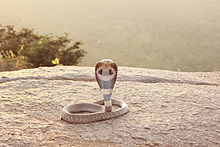Elapoidea
| Elapoidea | |
|---|---|

| |
| Indian cobra (Naja naja) | |
| Scientific classification | |
| Domain: | Eukaryota |
| Kingdom: | Animalia |
| Phylum: | Chordata |
| Class: | Reptilia |
| Order: | Squamata |
| Suborder: | Serpentes |
| Clade: | Colubroides |
| Superfamily: | Elapoidea Boie, 1827 |
| Families | |
The Elapoidea are a
paraphyletic in respect to elapids, and anywhere between four and nine families are now recognized.[5][6][7]
Taxonomy
In describing the subfamily
Cyclocorinae, Weinell et al. (2017) suggested some or all subfamilies of Lamprophiidae should be reevaluated at full family status as a way to prevent the alternative, which is classifying them as elapids.[6] This was followed in later studies such as Zaher et al. (2019).[8] Alternatively, Das et al. (2023) classified Cyclocoridae, Elapidae, Micrelapidae, and Lamprophiidae as distinct families, with all other families being subfamilies of Lamprophiidae; however, the Reptile Database still retains these as distinct families.[9][7]
Molecular studies suggest a rapid radiation of this superfamily within the Eocene, with all families diverging from one another by the end of the epoch. Although studies have found conflicting results, Cyclocoridae is generally considered the most basal member of the superfamily.[7]
Below is the phylogeny of Elapoidea after Weinell et al. (2017), with the interrelations of Elapid after Lee et al. (2016)[4] and Figueroa et al. (2016):[5]
| Elapoidea |
| |||||||||||||||||||||||||||||||||||||||||||||||||||
An alternative phylogeny was found by Das et al. (2023), subsuming many families into subfamilies of Lamprophiidae:[7]
| Elapoidea |
| ||||||||||||||||||
Families and subfamilies:[8][10]
- Family: Cyclocoridae Weinell & Brown, 2017—Philippine snakes
- Family: sea snakes, and others
- Family: Pseudaspididae Cope, 1893—mole snake, western keeled snake, and mock vipers
- Family: Prosymnidae Gray, 1849—shovel-snouted snakes
- Family: Psammophiidae Bourgeois, 1968—sand snakes and allies
- Family:
- Family: Atractaspididae Günther, 1858—African burrowing asps, stiletto snakes, harlequin snakes
- AtractaspidinaeGünther, 1858
- Aparallactinae Bourgeois, 1968
- Family: Pseudoxyrhophiidae Dowling, 1975—Malagasy hognose snakes, brook snakes, and allies
- Amplorhininae Meirte, 1992
- PseudoxyrhophiinaeDowling, 1975
- Family: Lamprophiidae Fitzinger, 1843—lamprophiids
Notes
- ^ The elapids in the past were considered to have two subfamilies–the Elapinae made of terrestrial species and Hydrophiinae made of the marine species.[1] In 1997, Slowinski, Knight and Rooney found in their phylogenetic analysis using amino acid sequences from venom proteins, that the Australasian terrestrial species nested within the Hydrophiinae. This led to removing the Australasian terrestrial species and placing them in Hydrophiinae.[2][1] This has been supported in subsequent recent genomic analyses, though these same studies also found the subfamily Elapinae to be paraphyletic in respect to the Hydrophiinae.[3][4][5] These studies have found coral snakes, cobras and mambas, kraits, and African gartersnakes forming successive outgroups to Hydrophiinae.[4][5] Since clade names are available for these groups with the exception of the Elapsoidea, bringing back the subfamilies Calliophiinae, Micrurinae, Najinae, and Bungarinae is ideal.
References
- ^ a b Mattison, C. (2007). The New Encyclopedia of Snakes. Princeton University Press.
- PMID 9417893.
- PMID 23627680.
- ^ PMID 26909162.
- ^ PMID 27603205.
- ^ PMID 29162550.
- ^ S2CID 255467733.
- ^ PMID 31075128.
- ^ "Advanced search | The Reptile Database". reptile-database.reptarium.cz. Retrieved 2023-08-22.
- ^ "Search results | The Reptile Database". reptile-database.reptarium.cz. Retrieved 2022-07-21.
- S2CID 255467733.
